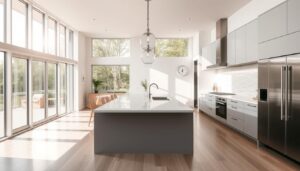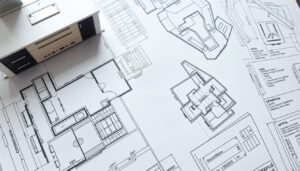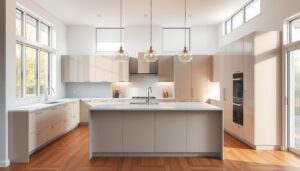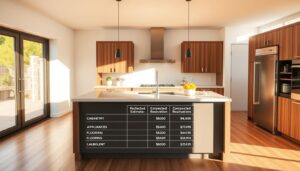Planning a new kitchen can be an exciting yet daunting task, especially when it comes to estimating costs. With renovation budgets ranging from £10,000 to £50,000, it’s crucial to have a clear understanding of where your money will go1. A well-planned budget helps avoid unexpected expenses and ensures your dream kitchen becomes a reality.
Recent trends show that the average cost for a mid-range kitchen renovation is between £8,000 and £9,000, covering essentials like appliances, worktops, sinks, and taps1. However, costs can escalate if you opt for structural changes or high-end finishes. Labour costs in the South East, for instance, can range from £3,500 to £10,000, depending on the job’s complexity1.
AVO Renovations understands the challenges of budgeting for a new kitchen. Their expert guidance and planning tools are designed to help homeowners like you make informed decisions. Whether you’re considering a minor update or a full makeover, AVO Renovations ensures every detail is accounted for, helping you stay within your means.
In this article, we’ll break down the costs, discuss design ideas, and provide tips for effective budgeting. With the right approach, your new kitchen can be both beautiful and affordable. Let’s get started on making your kitchen dreams a reality!
Introduction: Setting the Stage for Kitchen Renovations
Renovating your home is an exciting journey, and the kitchen is often at the heart of this transformation. It’s not just about updating appliances or layouts; it’s about creating a space that reflects your lifestyle and enhances your daily life. A well-designed kitchen can become the focal point of your home, where memories are made and shared2.
Over the years, kitchen design trends have evolved significantly, offering homeowners more options than ever before. Contemporary ideas now make it easier for anyone to embark on a renovation project, regardless of their budget or design experience. Whether you’re inspired by modern minimalism or rustic charm, there’s a way to bring your vision to life3.
Starting your project begins with inspiration. Gather ideas from magazines, online platforms, or showrooms to form a clear vision. Once you have a direction, it’s important to align your design choices with practical considerations like space, functionality, and budget. This balance ensures your project remains both beautiful and functional4.
A well-planned renovation not only enhances your home’s value but also improves your living experience. By focusing on cost-effective solutions and careful planning, you can create a kitchen that is both stylish and practical. Let’s explore how to make this vision a reality.
Understanding the Importance of Budgeting for Your Kitchen Renovation
Creating a new kitchen space is thrilling, but it comes with financial challenges. Setting a clear budget is vital to avoid overspending and ensure your project stays on track. A well-structured budget helps you make informed decisions and brings your vision to life.
Why Detailed Research is Essential
Detailed research is the cornerstone of any successful renovation. It helps you understand the costs of materials and labour, ensuring your project is both realistic and achievable. For instance, homeowners typically invest between 5% and 15% of their home’s value into a kitchen renovation project5. This investment can yield a significant return, with the national average ROI for a major kitchen renovation being approximately 54%5.
Selecting the right materials is crucial. They must match both the aesthetic you desire and the functionality you need. Understanding your space is equally important, as it influences both material choices and the overall layout. For example, medium-sized kitchens (150–350 sq-ft) account for 70% of remodels, with costs often between $25K–$75K6.
Without proper research, you might encounter issues like cost overruns or design flaws. For example, a smaller $28,000 kitchen remodel can yield a higher ROI of 71%7, showing the importance of careful planning.
The Role of AVO Renovations in Guiding You
Professional advice is invaluable during the budgeting process. AVO Renovations offers expert guidance, helping you navigate complex decisions and avoid common pitfalls. Their insights ensure your project is both beautiful and functional, keeping you within your means.
With AVO Renovations, you can create a kitchen that reflects your lifestyle and enhances your daily life. Their expertise helps you make informed decisions, ensuring every detail is accounted for and your vision becomes a reality.
Factors Influencing Kitchen Renovation Costs
When planning a kitchen makeover, understanding the factors that influence costs is key to staying on track. The price of your project can vary significantly based on the materials and labour involved8.
Material Options and Their Price Points
Your choice of materials greatly impacts the total cost. For instance, walls finished with premium paints or tiles can increase expenses, while opting for mid-range options offers a balance between style and affordability. Similarly, floor choices like natural stone or engineered wood vary widely in price, with natural stone costing between £3 and £10 per square metre9.
Tile selections also play a crucial role. Ceramic tiles are more budget-friendly, starting at £20 per square metre, whereas porcelain or natural stone tiles can range from £30 to £100 per square metre8. These choices not only affect aesthetics but also the overall price.
Labour, Installation, and Hidden Fees
Labour costs, including installation, often make up a significant portion of your budget. In the UK, these can range from £3,500 to £10,000, depending on location and complexity8. Hidden fees for plumbing, electrical work, or structural changes can also add to the total.
It’s essential to request detailed breakdowns from contractors to understand where your money is going and avoid unexpected surprises. Remember to also account for contingency funds, typically 10-20% of the total budget9.
Assessing Your Kitchen’s Current State and Needs
Before diving into your kitchen makeover, it’s essential to evaluate the current condition of your space. This assessment helps identify what needs updating and what can be retained, ensuring your project is both efficient and cost-effective.
Start by examining the structural and aesthetic elements. Cabinets and doors are often the first areas to show wear. Check for damage, warping, or outdated designs. If the framework is sturdy, consider painting or refacing rather than replacing them entirely10.
Next, inspect your countertops. Are they scratched, stained, or no longer aligning with your desired aesthetic? Replacing them can significantly refresh your kitchen’s look. Materials like quartz offer durability and low maintenance, making them a popular choice11.
- Evaluate each component to decide whether to repair or replace.
- Balance cost with quality, especially for materials like paint and countertops.
- Consider real-life examples, such as updating worktops for a modern feel without major changes.
By carefully assessing your kitchen’s current state, you can create a focused plan that enhances both functionality and style, ensuring your project stays on track and within budget.
Developing a Realistic Renovation Plan
Planning your kitchen renovation requires a clear strategy to ensure everything runs smoothly. A well-structured plan helps you stay organised and avoid costly surprises.
Setting Priorities and Project Scope
Start by identifying what needs immediate attention. Consider your lifestyle and how you use your kitchen. For instance, if you entertain frequently, your layout should facilitate social gatherings12. Creating a list of priorities helps you allocate resources effectively and avoid overspending.
Allocating a Contingency Budget
Unexpected expenses are common in renovations, so it’s wise to include a contingency fund. Allocating an additional 10% of your total budget for unforeseen costs can provide peace of mind13.
| Consideration | Key Points |
|---|---|
| Layout | Affects functionality and flow; plan according to usage patterns. |
| Time | Establish a realistic timeline to avoid delays. |
| Area | Maximise space efficiency, especially in smaller kitchens. |
| Size | Choose materials and fixtures that fit your kitchen dimensions. |
By setting clear priorities and including a contingency budget, you can manage your renovation effectively, ensuring it stays on track and within budget.
how to budget a kitchen renovation
Allocating funds for a kitchen renovation can be a complex process, but with the right approach, it becomes manageable. Start by setting a realistic budget that reflects your style preferences and functional needs. A well-structured budget ensures your project stays on track and delivers the desired results.
Style Choices Influence Spending
Your choice of style significantly impacts the budget. For instance, opting for a modern minimalistic look might require different allocations compared to a rustic charm. According to recent data, the average cost for a new kitchen installation in the UK ranges from £5,000 to £25,00014. This highlights the importance of aligning your design choices with your financial plan.
Incorporating a Kitchen Island
A kitchen island can enhance both the aesthetics and functionality of your space. When budgeting, consider the costs associated with adding an island, including materials and installation. This feature not only adds style but also provides additional work surfaces, making it a practical investment15.
Role of a Reputable Company
Hiring a reputable company like AVO Renovations can streamline the budgeting process. They offer expert guidance, helping you navigate complex decisions and avoid costly mistakes. Their insights ensure your project is both beautiful and functional, keeping you within your means16.
Cost-Saving Tips
To reduce costs without compromising on style or functionality, consider the following strategies:
- Keep the same layout to avoid expensive plumbing and electrical adjustments14.
- Reface cabinets instead of replacing them, saving up to 50% on costs16.
- Opt for affordable materials like laminate worktops and vinyl flooring14.
By carefully planning and making informed decisions, you can create a kitchen that reflects your style and meets your functional needs without exceeding your budget.
Designing Your Dream Kitchen on a Sensible Budget
Transforming your kitchen into a stylish and functional space doesn’t have to break the bank. With a little creativity and smart planning, you can achieve a high-end look without overspending. Let’s explore some practical design ideas that balance luxury and practicality.
Cabinetry, Layout, and Storage Ideas
Cabinetry is often the focal point of a kitchen. Choosing cost-effective materials like wood or laminate can create a luxurious appearance at a fraction of the cost. For instance, laminate worktops are durable and easy to maintain, making them a practical choice for busy households17.
Optimising your kitchen’s layout is crucial for functionality. Consider a U-shaped design for maximum storage and workflow efficiency. Incorporating multi-functional storage solutions, such as pull-out pantries or built-in utensil organisers, can enhance usability without compromising on style.
When it comes to flooring, materials like vinyl or engineered wood offer both style and affordability. These options are not only cost-effective but also easy to install, ensuring your kitchen remains both beautiful and functional17.
- Use vinyl wraps to refresh your worktops without replacement.
- Opt for ready-to-assemble cabinets to save on costs.
- Incorporate open shelving for a modern, airy feel.
By blending thoughtful design with practical solutions, you can create a kitchen that’s both inspiring and functional. Remember, it’s all about making smart choices that reflect your lifestyle and preferences.
Exploring Cost-Saving Strategies and Money-Smart Ideas
Embarking on a kitchen renovation offers an exciting opportunity to blend creativity with smart financial decisions. While it’s tempting to dive into every aspect of the project, balancing DIY efforts with professional assistance can make a significant difference in your overall spending.
DIY vs Professional Assistance: Finding the Right Balance
DIY projects can be a fantastic way to save money, but they also come with risks. For instance, vinyl wrapping worktops is a cost-effective alternative that homeowners can apply themselves with the right tools18. However, more complex tasks like plumbing or electrical work often require professional expertise to ensure safety and quality.
One practical way to cut costs is by tackling simpler projects yourself. Updating a sink area, for example, can be done on a budget by selecting affordable materials and fixtures. This not only saves money but also allows you to personalize the space according to your preferences.
- Consider DIY projects like painting or refacing cabinets to reduce expenses.
- Hire professionals for critical tasks that require specialised skills.
- Allocate money wisely, focusing on high-impact changes that enhance both functionality and aesthetics.
Smart decision-making is key to allocating your money effectively. By mixing DIY efforts with professional assistance, you can avoid common pitfalls and stay within your budget. Remember, it’s all about making informed choices that reflect your lifestyle and priorities.
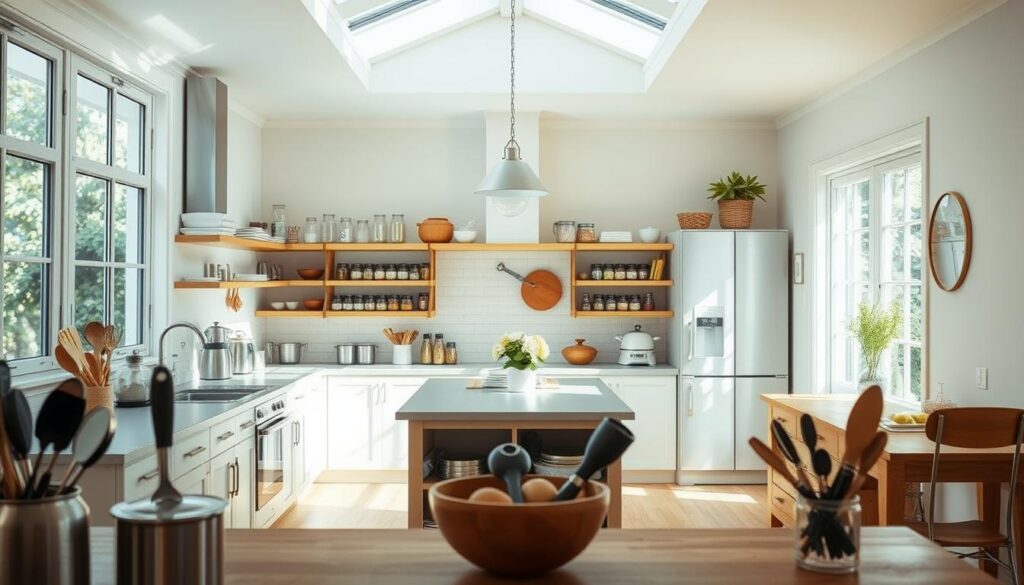
For those looking to save even more, consider exploring resources like the AARP’s guide to budgeting for additional tips and strategies. With careful planning and a bit of creativity, you can achieve a beautiful and functional kitchen without overspending.
Evaluating Material Choices: Worktops, Cabinets, Flooring and More
Choosing the right materials for your kitchen is a decision that balances style, functionality, and cost. With so many options available, it’s important to evaluate each choice carefully. For instance, worktops can range from affordable laminate to luxurious marble, with prices varying from £60 to £1,60019. Cabinets also play a significant role, with custom options costing between £300 and £1,500 per square foot, while semi-custom and stock options offer more budget-friendly alternatives20.
Appliances are not just functional; they can also serve as a design centerpiece. High-end appliances may require a larger upfront investment but offer enhanced aesthetics and long-term functionality21. Flooring materials like vinyl and hardwood provide a balance of cost and durability, with vinyl costing £3-£9 per square foot and hardwood ranging from £5-£15 per square foot19.
When considering a “much kitchen” upgrade, the choice between traditional and modern finishes can significantly impact costs. For example, a mid-range kitchen renovation in the UK typically costs between £20,000 and £30,000, while high-end projects can exceed £50,00019. It’s also important to consider material longevity and maintenance. Quartz and porcelain worktops, for instance, are known for their durability and resistance to scratches and stains, making them a practical choice for busy households20.
Ultimately, the key to a successful kitchen renovation is making informed decisions that align with your lifestyle and budget. By carefully evaluating each material choice, you can create a space that is both beautiful and functional without overspending.
Understanding Pricing Structures and Labour Charges
Understanding the pricing structures and labour charges in kitchen renovations can be complex, but breaking it down helps in managing expectations. Professionals often use various pricing models, such as fixed-price contracts, cost-plus contracts, or package deals. Each model has its pros and cons, and understanding them can help homeowners make informed decisions.
Detailed Cost Breakdowns
A typical kitchen renovation involves multiple components, each contributing to the overall cost. Material costs, for instance, can range from affordable options like laminate worktops (£20–£100 per square metre) to high-end materials like granite (£100–£400 per square metre)22. Labour costs, which account for 35-50% of the total budget, include installation fees that can range from £30 to £240 per day for a kitchen fitter22.
Hidden fees, such as permits and upgrades, can also add to the total cost. Permits, for example, can cost between £500 and £2,00023, while plumbing and electrical upgrades can account for 4-5% and 5% of the budget, respectively22.
What to Watch for in Hidden Costs
Hidden costs can quickly escalate your budget if not accounted for. These may include unexpected structural repairs, changes in material prices, or additional labour requirements. For example, a small kitchen renovation in the UK can cost around £20,000, but unexpected expenses can add an extra 10-20% to the total cost22.
To avoid these surprises, it’s essential to request fully itemised quotes from contractors. This ensures that every component, from worktops to labour, is clearly outlined. For instance, the installation of a typical 14-square-metre kitchen can cost around £3,500, but this figure can vary based on the materials and complexity of the job22.
By understanding these cost components and asking the right questions, homeowners can better manage their budgets and avoid unexpected expenses.
Remember, a well-planned budget and clear communication with your contractor are key to a successful and stress-free renovation.
Real-Life Inspirations and UK Case Studies
Discover how UK homeowners have transformed their houses into stunning spaces with clever design choices. One inspiring example is the Rapozes’ kitchen, which blends traditional architecture with modern elements, featuring a full wall of glass overlooking a 30m wooden pergola24. This design maximises natural light, creating a bright and inviting atmosphere.
The kitchen boasts a large island and warm pendant lighting, perfect for cooking and entertaining24. The use of Sigma 3 cabinetry in H-Line Sutton Burnt Umber and Madoc Urban Suede adds a touch of sophistication. Practical storage solutions like the MagnaSpace mini pull-out larder and Legrabox drawers ensure functionality24.
| Feature | Details |
|---|---|
| Windows | Full wall of glass for natural light |
| Materials | H-Line Sutton Burnt Umber, Madoc Urban Suede |
| Storage | MagnaSpace pull-out larder, Legrabox drawers |
Another case study highlights a utility room in Sutton Heather Slate, designed to accommodate future family needs24. These examples show how the right materials and design can transform any house into a beautiful home.
Planning Your Renovation Timeline and Project Coordination
Organising a renovation project is a complex but rewarding process that requires careful planning. By creating a clear timeline and coordinating tasks effectively, you can ensure your project finishes on time and within expectations.
Scheduling and Managing Trades
A well-structured schedule is essential for managing trades and minimising disruption. Start by breaking your project into key phases, such as planning, demolition, and installation. Allocate specific timeframes for each phase to maintain momentum. For example, the planning phase can take around 1-2 weeks, while demolition might only require a few days25.
When scheduling trades, ensure there’s a logical flow. For instance, plumbers and electricians should complete their work before installing flooring or fixtures. This sequence prevents delays and ensures each step is completed in the right order.
Step-by-Step Project Management Tips
Effective project management involves regular check-ins and contingency planning. Schedule weekly updates with your contractor to monitor progress and address any issues promptly. Additionally, include a 20% buffer in your budget for unexpected expenses, as 70% of projects experience delays due to unforeseen issues26.
Strike a balance between managing the project and maintaining your daily routine. Keep a shared online calendar with your contractor to track milestones and deadlines. This transparency helps everyone stay aligned and ensures the project moves smoothly toward its conclusion.
| Phase | Duration | Details |
|---|---|---|
| Planning | 1-2 weeks | Design finalisation and permit approvals |
| Demolition | 1-5 days | Removal of existing fixtures and materials |
| Installation | 2-4 weeks | Fitting of new fixtures and finishes |
Conclusion
Planning a kitchen makeover is an exciting journey, especially when you have a clear financial plan. As we’ve explored, careful preparation and expert guidance are key to a successful project. A well-managed budget kitchen can deliver impressive results, blending style and functionality without overspending.
Remember, a well-structured plan and realistic budget are essential. The average cost for a kitchen renovation in the UK ranges from £5,000 to £12,000, depending on materials and labour27. Mid-range projects typically cost between £20,000 and £30,000, while luxurious remodels can exceed £50,00027. Don’t forget to include a contingency fund of 10-15% for unplanned expenses27.
AVO Renovations offers expert support to simplify your journey. Their guidance helps you navigate complex decisions and avoid costly mistakes. By following the step-by-step advice provided, you can create a space that reflects your lifestyle and preferences.
Start your project with confidence today! For further resources or personalised help, contact AVO Renovations. Let’s turn your vision into reality!
FAQ
What are the key factors that influence the cost of a kitchen renovation?
The cost of a kitchen renovation is primarily influenced by the materials you choose, such as cabinets, countertops, and flooring, as well as labour costs and the scope of the project. Other factors include the size of your kitchen, the complexity of the design, and any additional features like an island or high-end appliances.
How can I determine the right budget for my kitchen renovation?
Start by assessing your needs and priorities. Consider the cost of materials, labour, and any structural changes. A good rule of thumb is to allocate at least 10-15% of your home’s value to the kitchen renovation. Always include a contingency fund to cover unexpected expenses.
What are the most cost-effective materials for kitchen worktops?
Laminate and engineered wood are cost-effective options for kitchen worktops. They offer durability and a wide range of designs without the high price tag of natural stone or solid wood. Additionally, they are easy to install and maintain.
Can I save money by doing some of the work myself?
Yes, taking on tasks like painting walls or assembling cabinets can help reduce costs. However, complex tasks like plumbing or electrical work should be left to professionals to ensure safety and quality. Always weigh the time and effort against the potential savings.
How long does a typical kitchen renovation take?
The duration of a kitchen renovation depends on the scope of the project. Simple updates, like replacing cabinets and flooring, can take a few weeks, while a full renovation, including structural changes, may take several months. Plan accordingly and consider temporary kitchen arrangements if needed.
What should I look for when hiring a renovation company?
Look for companies with a proven track record, positive reviews, and proper certifications. Ensure they provide detailed quotes and timelines. A reputable company will also offer warranties and be transparent about their process and costs.
How can I ensure my new kitchen is energy-efficient?
Choose energy-efficient appliances with high ratings, install LED lighting, and consider adding insulation to reduce heat loss. Modern designs often incorporate eco-friendly materials, which can also contribute to energy efficiency.
What are the latest trends in kitchen design?
Current trends include minimalistic layouts, open-plan living, and the use of light colours for a modern look. Incorporating smart storage solutions and multi-functional islands is also popular. Sustainability is a key focus, with many opting for recycled materials and eco-friendly finishes.
Source Links
- How Much Does a Kitchen Renovation REALLY Cost? | Fifi McGee
- 3 Steps to Remodeling a Kitchen You Should Know [Infographic] | RWC
- In what order do I renovate a kitchen? – Reliance Cabinetry
- A Step-by-Step Kitchen Remodeling Timeline
- How to Budget Your Kitchen Renovation | Cabinet World of PA
- Guide to Kitchen & Bath Remodeling: How to Budget for a Kitchen Remodel | Revival House
- What Does It Cost to Remodel a Kitchen? Set Your Renovation Budget
- What Is the Cost to Do a Kitchen Renovation? Pricing Factors Explained
- How much does a kitchen renovation cost?
- Kitchen Renovation: A Complete Guide – Merrill Construction Group
- 10 Expert Kitchen Renovation Tips for a Stunning Upgrade – Ruvati USA
- How to keep your renovation on budget
- How to Successfully Plan Your New Kitchen Budget
- Renovating your kitchen on a budget | Kitchen Ideas | B&Q
- How Much Does a New Kitchen Cost? What to Budget for Kitchen Design & Installation – Build It
- Kitchen Remodel on a Budget: 5 Basics
- How much should you spend on a kitchen renovation?
- 8 budget kitchen remodeling ideas – Which? News
- How Much Does a Kitchen Renovation Cost? Estimate Your Budget
- Our ultimate guide to kitchen renovation
- Kitchen Renovation Cost: Budgeting for Your Dream Space
- How Much Does a Kitchen Renovation Cost? A Detailed Pricing Guide
- How Much Does It Cost to Remodel Your Kitchen in 2025?
- A Grand Designs Kitchen by Sigma 3 Kitchens – Find Your Kitchen Inspiration | Blog
- Understanding Kitchen Renovation Timelines and Phases
- The Ultimate Kitchen Remodeling Guide: Expert Tips and Strategies
- What Is the Average Kitchen Renovation Cost? A Practical Overview


